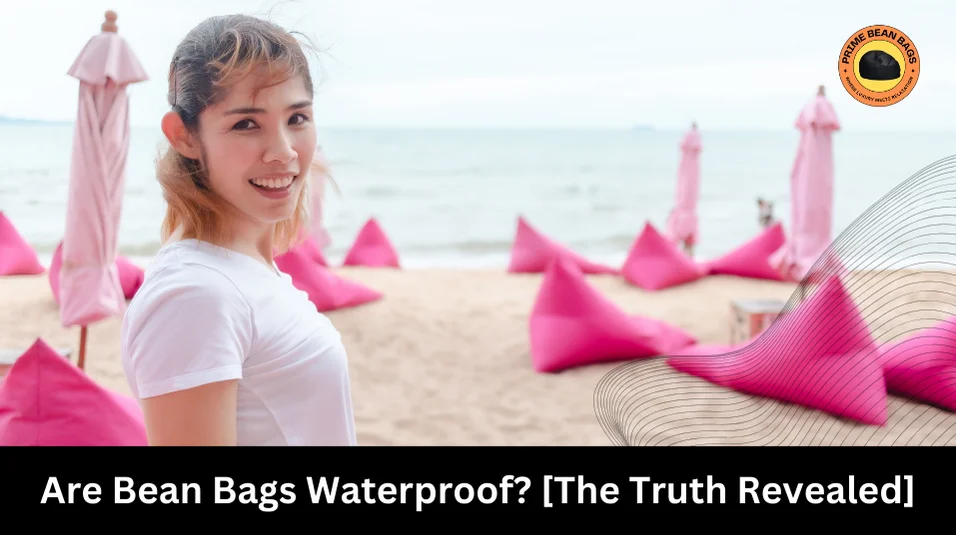Few contemporary home furnishings have become as ubiquitous and appealing as bean bags. These multipurpose sofas, chairs, and tables can be found in nearly every indoor or outdoor setting. They’re well-liked for the ease, elegance, and versatility they provide. One typical question that arises, though, are bean bags waterproof or not?
In this article, we’ll explore the depths of bean bags to learn the truth about their ability to withstand water. The construction components, common misconceptions, and useful tips for bean bag owners will all be discussed. Let’s get started on our mission to solve the mystery of bean bags waterproofing.
Table of Contents
Understanding Bean Bags and their Construction
Let’s take a step back and examine what bean bags are and how they’re made before we dive into the riddle of how they are developed. Bean bags, at their core, are merely padded bags filled with beans or other small pellets for added comfort. Because of the wide range of sizes, styles, and materials available, these totes can easily be customized to suit the user’s needs and preferences.
The Different Types of Bean Bags
There are several varieties of bean bags which are available. The most typical examples are:
Classic Bean Bags
there are the classic bean bags, which can be either round or pear-shaped and are ideal for relaxing in.
Bean Bag Chairs
bean bag chairs with a back and armrests provide greater support and structure than traditional bean bags.
Outdoor Bean Bags:
Outdoor bean bags are constructed to endure rain, snow, and sun, making them a great choice for outside seating.
Materials Used in Making Bean Bags
The materials used to create bean bags have a substantial effect on their comfort, durability, and, yes, water resistance. Common substances include:
Vinyl: Used frequently for its durability and convenience of cleaning, vinyl bean bags are water-resistant but not completely waterproof.
Polyester: Polyester bean bags are renowned for their comfort and suppleness. They are also somewhat water-resistant.
Nylon: Bean bags made of nylon are lightweight and durable, making them ideal for outdoor use. Typically, they are water-resistant.
Canvas: Canvas bean bags have a robust and natural appearance. Although they are not completely waterproof, they can withstand mild moisture.
Now that we have a fundamental comprehension of bean bags and their construction, let’s examine the urban legend surrounding their waterproofing.
Read More: The Ultimate Comparison for Lovesac Bean Bags size
Truth behind Are Bean Bags Waterproof?
A common misconception regarding bean bag chairs is that they are naturally impermeable. Probably due to their frequently synthetic and water-resistant cover materials. However, it is essential to note that not all bean bags are created equivalent, and their resistance to water varies greatly.
Factors Contributing to the Belief
Several factors support the notion that bean sacks are waterproof:
- Synthetic Materials: Many bean bag covers are made from synthetic materials such as vinyl or nylon, which inherently repel water to some extent.
- Tightly Stitched Seams: Seams that are tightly stitched prevent water from readily penetrating well-constructed bean bags.
- Resistance to Stains: The ability of bean bags to resist stains is often confused with waterproofing, as liquids may bead up on the surface without immediate absorption.
Instances Where Waterproofing Is Desirable
Understanding the waterproofing fallacy does not negate the high desirability of waterproof bean bags in certain situations.
- Outdoor Use: If you intend to use your bean bags outdoors, they must be able to withstand precipitation and rain.
- Poolside Lounging: Bean bag chairs near pools or other water sources are susceptible to splashes and spillage.
- Kids and Pets: In households with children or animals, accidents and spillage are commonplace.
While water-resistant bean bags can withstand light moisture exposure, there is a distinction between water-resistant and impermeable, which we will discuss next.
The Truth About Bean Bags Material
To learn the truth about bean bag water resistance, it is necessary to investigate the inherent properties of the materials commonly used to make them.
Vinyl and Nylon
Vinyl and nylon are two popular materials for bean bag cover materials. They are both synthetic, so they have some inherent water resistance. When liquids are released on these materials, they tend to bead up on the surface as opposed to absorbing immediately.
It is essential to observe, however, that this resistance has its limits. Even vinyl and nylon can become permeable to water with sufficient time or exposure. This is why they are referred to as water-resistant as opposed to impermeable.
Polyester and Canvas
Due to their suppleness and comfort, polyester and canvas are typically used for bean bag covers. Despite the fact that they are not as inherently water-resistant as vinyl or nylon, they can still provide some water resistance. However, they are typically less effective than synthetic materials at repelling precipitation.
For bean bags made from polyester or canvas, prolonged exposure to moisture must be handled with additional caution.
Waterproof Bean Bags vs. Water-Resistant Bean Bags
To distinguish between impermeable bean bags and water-resistant bean bags:
- Waterproof Bean Bags: These are specifically designed and treated to be impervious to water. They are impervious to water when submerged or subjected to heavy precipitation.
- Water-Resistant Bean Bags: These are not completely impervious to water, but can withstand variable degrees of exposure to mild moisture and spills.
When purchasing bean bags, it is essential to comprehend this distinction and select the appropriate type.
How to Identify Water-Resistant Bean Bags
To recognize water-resistant bean sacks, search for the following characteristics:
Material: Check the material of the cover of the bean bag. Vinyl and nylon are more likely to have water-resistant exteriors.
Seam Quality: Examine the seams for tight stitching, which prevents water from penetrating through the stitching gaps.
Product Descriptions: Carefully read product descriptions. Frequently, manufacturers indicate whether a bean bag is water-resistant or impermeable.
Now that the distinction has been clarified, let’s examine how to make bean bags more impermeable and practical considerations for their use.
How to Make Bean Bags Waterproof?
If you have water-resistant bean bags and want to improve their permeability, you can employ the following strategies:
- Waterproof Covers: Invest in waterproof covers designed for the size and configuration of your bean bag chair. These covers are typically composed of PVC or polyester with a coating.
- Seam Sealing: Seal the seams of your bean bag cover with seam sealer or impermeable tape to increase its water resistance.
- Scotchgard or Waterproof Spray: Scotchgard or Waterproof Spray: Use a fabric waterproofing spray such as Scotchgard to add a layer of water resistance to the cover of your bean bag.
- Bean Bag Liners: Some bean bags come with inner liners that preserve the filling. Ensure that these liners are made of a water-resistant material.

